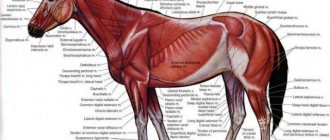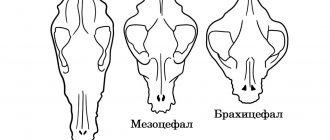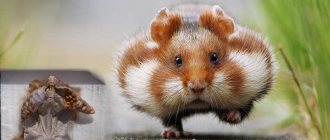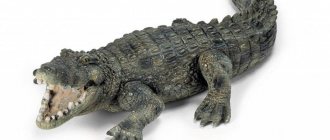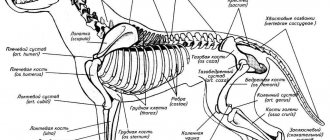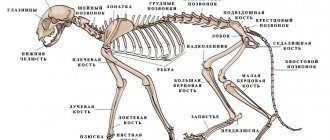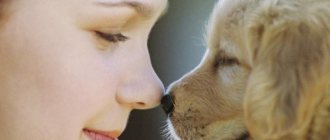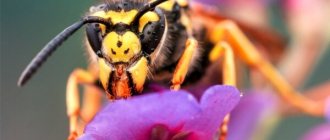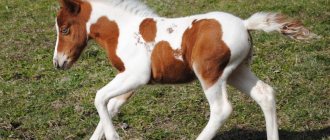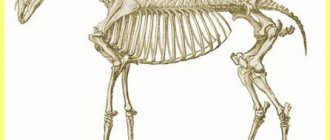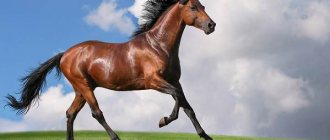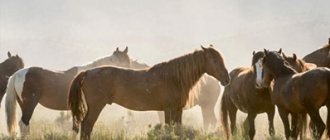The study of the anatomy of mares and horses was founded by Leonardo da Vinci. His book Hippotomy became an example for compiling many subsequent works related to the body structure of these animals. It examines in detail not only the body, but also the structure of the horse’s skull.
Basics or articles
The study of anatomy begins with an examination of the skeleton and parts of the animal. The horse skeleton consists of 252 bones that perform motor and support functions. The bones of such a large but very dynamic animal are subject to large static loads. Therefore, the skeleton is very strong.
For comparison, horse bones can withstand compression 2-3 times greater than granite, and in terms of tensile strength they are close to cast iron or brass.
You can find out in more detail what the horse’s skeleton is made of, as well as how many bones there are, by looking at the photo.
Head and neck
The head is divided into facial and occipital parts. The first includes ears and forehead, eyes, ganache. In front is the horse's muzzle.
Ganache is the name given to the chewing muscles that hold the lower jaw in place. Externally, this structure looks like raised protrusions below the horse’s ears.
A horse's head, unlike a pony's, must first of all be proportional to the body. In ponies it is much larger in relation to the overall size of the body. The horse's skull consists of 34 very strong flat or concave bones.
A horse's muzzle is the animal's upper lip combined with the nose.
The nostrils and chin (lower jaw) are examined separately. A disadvantage is either a too small or large head. Considering the structure of the head, the following parts are distinguished: ears, forehead, temples, eyes, cheekbones, cheeks, bridge of the nose, nose (nostrils), mouth, cheeks or ganache.
When describing articles, attention is paid to the back of the head. This is the part of the head located behind the ears and connecting the head to the neck.
It is believed that a short poll contributes to better contact between the rider and the horse.
Main articles: skeleton, horse skull and others
A formation that performs a specific function in the body is called an article. Knowledge of them is necessary for every beginning groom.
A horse's muzzle can have different types of profile. This directly depends on the breed of the animal.
Thus, a horse in profile can be of the following types:
We also recommend reading:
Zebra: white with black stripes, or black with white stripes? Horse running: features of performance and types of gaits What horses prefer and like to eat Roan color. All about horse color
- concave
- convex
- straight
- wavy
Also, a horse's muzzle differs in size, which must be taken into account when purchasing a bridle.
Head . This horse's position must be proportional to its body, because if it exceeds the required size, then the balance in the animal's body is disturbed, causing additional stress on the forelimbs, and this, in turn, leads to health problems. The bones in a horse's skull are especially strong because they protect the brain.
The horse's breathing should be even and calm, and this characteristic depends on the distance between the branches of the lower jaw, as well as the large nostrils. The standard of an animal's ears is determined by its breed, but in absolutely all animals they must be symmetrical. A healthy horse's eyes do not have eyesores or other clouding. They must be clean and large. Sunken eyes are called “pig eyes” and do not at all decorate the animal.
The condition of the oral cavity helps determine the age of the animal. As a standard, stallions have more teeth than mares, as the latter rarely have canines. A total of 12 incisors - six above and six below - are located in front, on the upper and lower jaws. They are followed by a toothless edge, which is adapted for controlling horses with a bit.
Age can be determined by the shape, length or color of teeth. A horse's molars are not as white as milk teeth, and are much longer than them.
The neck affects such characteristics as the animal's speed, jumping ability and the beauty of its physique. The neck and head are the regulators of the horse's balance. A neck that is set at forty-five degrees to the horizontal is considered normal. It should also be 25 to 30 percent longer than the head. The short neck limits the extension of the animal's front legs, which makes it slower. When it passes into the withers, it forms the top line.
withers are the part that protrudes between the neck and back and is immovable. Heavy draft horses have low withers, while sporting animals have high and long withers.
The shoulder consists of the scapula and humerus. Heavy draft horses have short shoulders, while long ones are desirable for racehorses. Free movement is ensured by a shoulder blade located at an angle of forty-five degrees to the horizontal. Shoulder blades that are at a large angle indicate that the horse may begin to limp under high loads.
In a healthy animal, the elbow is pressed tightly to the chest. If the horse's muscles are poorly developed, the elbow is set back, which leads to possible injuries caused by the hind legs and the front legs.
The wrist should be dry, long and well defined.
A horse with a short forearm moves more gracefully, while an animal with a long forearm moves its hind legs more sweepingly.
in the pastern , so it should be short and correctly positioned.
The horse's gait and endurance directly depend on the fetlock joints . They should be wide and well developed.
The hooves on the legs of a healthy horse are shiny, there are no cracks on them, and the soles of the hooves are clean and show no signs of inflammation. They can be of completely different colors, but the darker they are, the stronger they are.
A wide and deep chest is a sign of a well-developed animal. This part of the horse's body is quite narrow if he is athletic.
The back and lower back, also known as the top line , should be level and straight. An animal whose back and lower back are longer than the length of its head will have an easy walk.
The croup , that is, the rear part of the horse, occupies 35 percent of the entire body. It can be oblique, straight or oval, but always wide. The horse's croup attaches to itself the strongest muscles, which must push and lift the horse while moving.
Trained animals have a toned abdomen . If this part of the animal’s body is saggy, then this indicates flat ribs and a crooked back. It may also be present in mares that have foaled many times, or in animals that once suffered from rickets.
The hock joint is the support of the pelvic girdle. Its important function is performed by the heel bone. If the animal was overloaded, then there is a high probability of swelling on the horse’s legs, which threatens the development of diseases such as curba and spar.
The horse's tail is in line with the croup. If the tail is too thin, this indicates the fragility of the animal. The tail also helps horses communicate in the herd.
Teeth
Horse teeth are of great importance, since these animals are herbivores and the special structure of the digestive system requires constant chewing of rough plant feed.
The horse's teeth are very strong; in front of both jaws there are incisors, followed by molars. An adult horse should normally have 6 incisors and 12 molars. And in stallions, after the incisors, on each side there is one additional tooth - clicks.
The criteria by which a horse's back is assessed are: width, length, good muscle development.
Eyes
These animals have lateral eyes, which helps increase vision. If you need to see what is happening on the left or right side, it is not necessary for the horse to turn his head and tense his muscles. But there is one nuance regarding vision. Everything in front of her nose and behind her rump falls into her blind spot.
The pupil and iris are dark in color and brown or black. Pigmentation is also allowed. This does not in any way affect the overall working qualities of the animal.
The horse's eye is moderately convex, with a thin eyelid. Excessive convexity indicates disturbances in the functioning of the visual apparatus.
Anatomical structure of the head
Let's look at each part of the skull separately.
Muzzle
There are several variations of the horse profile:
- hook-nosed;
- concave;
- straight.
Each of these types differs from the others in bone configuration and is found in different horse breeds. The pike (concave) profile is most often found in horses that live in deserts and savannas. It may have a concave temporal fossa. This structure of the muzzle minimizes the entry of foreign objects into the nostrils.
The straight profile increases air flow to the horse's nostrils and ensures increased gas exchange through the opening leading into the nasal cavity. Riding thoroughbreds and working horses have such a muzzle.
The hump-nosed profile is characteristic of animals with a rough body structure, including trotters and Hanoverian horses.
In the horse skull, the angles of the lower jaw play a large role. A fist should normally fit between them. If this distance is small, the animal will not work well in assembly.
Eyes
This organ is responsible for the horse’s perception of the surrounding world. Horse vision has a wide viewing angle. The lateral localization of the eyeballs allows the animal to see what is happening on the sides without turning its head. But horses also have a “blind spot”, which is located in front of their frontal sinus and in the back of the croup.
Horse eyes should have long eyelashes and thin eyelids. Excessively bulging eyeballs indicate vision problems. The pupil and iris around it should have a dark color. If a horse’s pigmentation is changed, then this phenomenon is called “magpie’s eye.” However, experienced horse breeders and veterinarians note that such a deviation does not have any effect on the health and mood of the horses.
Teeth
Horse teeth are distinguished by their large size and strong structure. The oral cavity of adult males contains 40 teeth, including 4 sharp canines, 24 full molars and 12 incisor teeth. Females have no fangs.
Sometimes animals exhibit dental abnormalities. This could be an incorrect bite, a protruding jaw, etc. The toothless zone runs from the edge of the incisor and ends near the first molar. This area is used to install a bit or snaffle. Read more about horse teeth in the article “How many teeth does a horse have”
Ears
The horse's ears should be the same size as the head. These sensory organs include elastic cartilage and are characterized by mobility. They are located high and most often stand when the animal is active. They can have pointed, straight or rounded ends.
Based on the movement and condition of this part of the body, one can draw conclusions about the psycho-emotional state and a number of shortcomings of the horse. For example, if the ears are motionless, this may indicate that the animal is deaf. If they are too mobile, then this may be a consequence of decreased visual function. With the help of sounds, horses try to fill the lack of data about the world around them. Relaxed animals have slightly tilted ears.
Tail
The tail is formed by a rib and hair.
The last extension of the spine is called the reticulum. Thanks to the muscles, the mobility of the tail is ensured.
The tail not only helps horses protect themselves from blood-sucking insects, but also plays a role in coordinating movements. Today, many horse owners braid their pets' tails with ribbons.
Ears
Ears for horses and ponies are a very important sensory organ. Having good hearing, animals can easily navigate in the dark, in unfamiliar areas, and recognize signals at a distance of hundreds of meters. Horses' ears themselves consist of soft cartilaginous tissue, are high, most often straight and very mobile. The horse can turn each ear in different directions independently of each other. In addition, the ears are an excellent reflection of the emotional state, showing anger, irritation, fear or interest of the animal, as in the photo.
The horse has five main senses:
- gustatory
- olfactory
- tactile
- auditory
- visual
The organ of smell is located in the nasal cavity. Horses have a particularly sensitive sense of smell, which allows them to determine the condition of the feed and refuse it if the food is spoiled.
The organ of vision is the eye, which consists of the eyeball connected to the brain and other organs.
The eyeball is located in the bony socket and consists of a membrane, blood vessels, nerves and light-refracting media.
Skeletal structure
The main components of the horse skeleton can be combined into several main groups: the skull, elements of the spinal column, chest and limbs. They all have different sizes and shapes, but even the smallest bone has a huge impact on the functioning of the organs and the ability of the animal to function normally.
Skull box
At first glance, it may seem that the horse’s skull is a single bone, to which only elements of the jaw are adjacent, but in fact there are many more components.
Familiarize yourself with the growth characteristics of horses.
What are the main bones that make up
If you look closely at the skull, you will notice that it consists of many individual parts that are combined into the following set of bones:
- incisal;
- nasal;
- maxillary;
- mandibular;
- zygomatic;
- tear;
- frontal;
- parietal;
- temporal;
- occipital;
- orbital (orbit).
The structure of the horse's skull Together, they give the skull a complete look and serve as reliable protection for many important organs.
Did you know? Horses are excellent at distinguishing musical styles and can even recognize their favorite composition, although calm and melodic music is preferable for them.
How many bones are there?
The horse's skull is a collection of 34 predominantly concave or concave-flat plates, rigidly fastened together with sutures . However, this set also contains three auditory ossicles, in each cavity of the middle ear.
Organs that are located in the skull
The skull of any living creature must reliably protect the brain from any unwanted external influences. Given the importance of this organ, it is not surprising that all the bones of the horse's skull are so strong.
It also contains the hearing organs, the eye sockets contain the organs of vision, and in addition to this, the digestive tract, vocal cords and respiratory passages originate from the nasal and oral cavities.
Spinal column
In this part of the horse skeleton there are only 53–55 vertebrae, of which:
- 7 cervical;
- 18 breast;
- 6 lumbar;
- 5 sacral;
- 17–19 tail.
The spinal column originates at the base of the skull and stretches along the length of the entire body of the animal.
This made it possible to identify several main zones: cervical, dorsal, lumbar and caudal. Did you know? Horses are able to recognize themselves and their relatives in pictures, with whom they even “greet” with a quiet neigh.
In any of them, sequential attachment of the vertebrae to each other was made possible thanks to cartilaginous tissue. From above (closer to the thoracic region), each “part” of the spinal column is characterized by a hole in its central part, which is designed to accommodate the spinal cord.
In the lumbar region, the vertebrae fuse and form the sacrum, and the vertebrae of the caudal zone are already attached to it.
Rib cage
There are 37 bones in the horse's chest, and its base is 18 pairs of ribs. They are symmetrically located and attached to the spinal column.
There are two types of edges: true (8 pairs) and false (10 pairs). The opposite end of the first ones closes on the chest with hard cartilaginous tissue (reminiscent of softened bone) for better fixation, and the false ribs do not have a connection with the sternum and can generally end in the muscles (the so-called “hanging”).
A horse's rib is an arched bone, on top of which there is a neck, tubercle and head. The latter enters the costal fossa of the vertebra and forms the joint. In turn, the tubercles are connected to the transverse process of the thoracic vertebral zone.
Find out how much the average horse weighs.
In horses, it is not similar to a similar “detail” of the skeleton of cattle and pigs. Here the sternum is slightly flattened on the sides and has lateral notches in the joints (with their help, the connection occurs with the cartilage of the real ribs).
The chest is bounded at the top by the vertebrae of the thoracic region, at the sides by the ribs, and at the bottom by the sternum. Its shape resembles a flattened cone, especially in the area of attachment of muscle and bone tissue to the shoulder girdle. The entrance to the sternum is located closer to the neck, between the first ribs. The exit point, on the contrary, is directed backward and is located between the last pair of ribs.
Limbs
The horse's legs deserve special attention.
Here all the bones can be divided into two groups:
- anterior, the main of which are the scapula, humerus, radius, carpals, metacarpals, fetlocks and ungulates;
- rear: pelvic bone, femur, tibia and fibula, hock bones.
Spatula
A flat, more triangular bone connected to the humerus. A ridge runs along its entire length - the so-called “scapular tubercle”. Below, the scapula is located on the ribs and is separated from them by cartilage. Together with the bone and joint of the shoulder, the scapula forms the glenohumeral joint.
Important! The angle of the blade directly affects its length. The higher its value , the longer it will be, which has a very positive effect on all the horse’s movements.
Brachial bone
A relatively short bone, in which several main parts are distinguished: the head, the greater trochanter and the epicondyles, located in the area of the elbow joint. Together with the scapula, radius, fetlock, coronoid, ulna, carpal and metacarpal bones, the humerus forms the basis of the forelimbs.
Radial and ulnar
Together these bones create the forearm. The radial one is much larger, and the ulnar one is smaller and is located immediately behind it. Between them there are blood vessels, and in the upper and lower parts there are ligaments that attach the muscles. The body of these two bones gradually joins and tapers towards the wrist. In the upper third, the ulna is separated from the radius by the interosseous space.
Carpals
The carpal bones are several rows of short, asymmetrical bones that together have up to 8 constituent elements. They have 2 joints (movable), located closer to the radius and the first row of carpal bones.
Learn how to care for your horse's hooves.
Metacarpal and two slates
Long bones that act as supports for the large bone of the limb. Slate ones are much thinner than all the others, and for a long time were considered useless. However, today it is already known for sure: they perfectly support the metacarpal bone.
Putovaya
Located between the hoof and the brush, at the top it is supplemented with a fetlock joint. This short and hollow bone has two ends: proximal and distal, as well as two surfaces: dorsal and volar, which connect to the lateral edges without a sharp transition.
Ungulate
Performs the function of a “base” for the finger and short coronoid bones, and includes a cartilaginous layer. All together - an excellent filling for the cornea, which is better known as the “hoof”. The hoof of the front leg is more rounded, slightly flattened on the sides and flat, while the rear hoof protrudes somewhat forward and is located at a large angle of inclination.
Pelvic
It consists of two symmetrical parts connected to each other by a pelvic suture. The innominate bones (the second name for the pelvic bones) are the skeleton of the pelvic cavity and the ligament for the hind leg, and in addition to this, they play the role of a “lever” during the movement of the animal. This “lever” also consists of three parts: the ilium, the ischium and the pubis.
Familiarize yourself with the rules for shoeing horses.
Summary
When considering the structure of horses, the main attention is paid to the articles. They allow you to determine the scope of use of the animal in accordance with its parameters. This is influenced by various indicators, for example, the volume of the chest, the shape of the neck and croup, etc.
Thus, speed and agility are important for racehorses, which is expressed in appearance and build. They are taller, lighter, their muscles are developed, but less than those of heavy trucks. The article lists only the main articles; in fact, there are many more.
Horse skin
Examination of the skin allows you to understand the state of the animal’s digestive system and how well its metabolism works.
It protects the body from the harmful effects of the external environment and promotes the production of vitamin D. The skin consists of the following layers:
- The epidermis in which hair grows.
- Dermis. It consists of two layers. The first contains sebaceous and sweat glands, many blood vessels and nerve endings. In the second there are fibers and collagen plexuses.
- The subcutaneous layer contains reserves of nutrients presented in the form of fat.
At the base of the skin are sebaceous glands, which are responsible for lubricating hair and skin, thereby preventing breakage and cracks.
Without sweat glands, thermoregulation could not exist, since they secrete sweat, helping to cool the animal.
Milk is produced and stored in the mammary glands. A mare can produce about 20 liters of milk per day.
